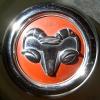-
Posts
6,969 -
Joined
-
Last visited
-
Days Won
73
Content Type
Links Directory
Profiles
Articles
Forums
Downloads
Store
Gallery
Blogs
Events
Everything posted by JBNeal
-
additional information - carburetor priming made easy
-

supply line/return for heavy duty oil filter
JBNeal replied to rlcokc@aol.com's topic in Mopar Flathead Truck Forum
Sock filters are basically layered cotton fabric of a thread count that allows most fluid through but catches most particulate contamination...modern pleated filters are made of a paper porous enough to emulate the sock filter, but are cheaper to produce. The media itself works independent of fluid flow. In the bypass flow systems, fluid flow varies with operation of the bypass valve, so not all fluid is filtered during lubrication...in full flow systems, all fluid is filtered at system pressure during lubrication. Typically, gasoline engines with bypass oil filtration are less susceptible to the effects of contamination than modern engines with full flow filtration, as modern engines have much tighter tolerances and operate at higher rpms. For flatheads, oil filters were optional, which gives ya an idea of how clean oil needed to be to operate...kinda like push mowers that ya only change the oil every spring -

supply line/return for heavy duty oil filter
JBNeal replied to rlcokc@aol.com's topic in Mopar Flathead Truck Forum
I've been stewing on this for awhile and cannot think of a good reason that fluid direction through the filtering media makes any difference here as these are not full flow systems, especially the sock filter...thinking about all of the stories that I've heard where a roll of toilet paper was substituted for the correct sock filter kinda backs up this thinking...the perforated dome appears to hold the filter in place and appears to act as a splash dampener for both directions of flow...so as long as the correct filter is in place and the lid is screwed down adequately and the sealing gaskets are in good shape, either direction should work -
The original setup, when properly maintained, is fairly robust, and the fire risk is there but not as dangerous as ya might think...a dripping fuel bowl will mist during engine operation as the nearby cooling fan will disperse droplets, and the heat from the engine will flash off the volatiles...a severe leak will degrade engine performance, usually seen as stumbling at higher rpms as this reservoir level drops too low to be effective, and these performance drops would be significant enough to require attention. I was taught to remove the sediment bowls every spring and scrub the crud outta the glass, as well as replace the filter and gasket as required...this coincided with cleaning the oil bath air filter and changing the crankcase oil and lubricating the chassis, distributor, generator, etc
-

supply line/return for heavy duty oil filter
JBNeal replied to rlcokc@aol.com's topic in Mopar Flathead Truck Forum
It is my understanding that the filter has pressurized oil fed through the center tube outwards, where heavier particles settle in the bottom of the housing to form a sludge to be cleaned out periodically...this outward pressure forces the filter against the housing uniformly...return oil port is on the side back towards the block bypass valve... If ya can visualize the assembly of the exploded view, you can see that the oil line going to the top port extends below the oil line going to the bottom port -
Flathead oil pumps are on the side of the block, directly opposite of the distributor...sounds like ya dinged up the pickup float that pivots on the oil pump draw tube, that can probably be massaged back into shape
-
The primary sediment bowl is on the fuel pump, whereas the filter bowl before the carburetor is a small reservoir for a standby fuel reserve when the hammer is dropped...so there are technically 4 fuel reservoirs on the truck: carb, filter, pump, tank, with the filter and pump reserves on standby for such instances as starting from a stop with a full load and downshifting while climbing steep grades, allowing a smooth application of shaft power. The filter bowl catches smaller contaminants from entering the carburetor by forcing the fuel through a filtering medium, as by this point the larger contaminants have fallen out of the fuel stream in the pump sediment bowl. Depending on the filter body you have, there are 2 possible pleated fuel filter replacements available...the stone works fine when its clean, but they do degrade over time and can fall apart if they bounce off the shop floor when a case of the butterfingers hits. I've used both and they work well
-
I live in a rural area 10 miles from our zip code post office so it was a surprise last year to see a city route truck delivering on a Sunday...that happens a few times a month now, and late morning deliveries have transitioned to mid- to late-afternoon deliveries...and the usual carrier has given way to a rotating carrier roster, so we never know what vehicle is gonna make a delivery...but that's just on my side of the road. Across the road is a different zip code, that post office is 15 miles away in an even smaller town, and the same nutty carrier comes barreling down the road in her beat up Grand Marquis, straddling the hump to keep that old buggy in between the ditches...she manages to make her late morning deliveries at the same time she has for the last 15 yrs
-
That stone is a filter, believe it or not, and the voids can gum up with varnish..take the stone out and soak it in lacquer thinner for a few days, rinse off with lacquer and repeat...typically that glass bowl should be almost full at idle, with occasional air bubbles forming when the fuel pump shifts out of bypass mode
-

CHS Ricardo Cavallero S.R.L manual steering boxes
JBNeal replied to bkahler's topic in Mopar Flathead Truck Forum
Just for insurance, push that cardboard tube halfway out and apply grease to the bearings, then flip it over and repeat, just to keep the bearings held in place in case ya get a case of the butterfingers... The last time I cold riveted anything, the rivet already had a head formed on one end...maybe that new shaft could be worked before install...which means ya might need to machine out a setting die so ya can whop the bejeezus outta one end of that li'l shaft...but then the other shaft end would need to be mushroomed or welded, so that might be too much work compared to the set screw approach...the last few small shafts I've worked with, I ended up putting a dimple in the middle of the shaft end since they were seated in tight bores...that dimple was just enough to restrict the shaft from coming loose, but still allowed the shaft to rotate a little, allowing for lubrication... -

CHS Ricardo Cavallero S.R.L manual steering boxes
JBNeal replied to bkahler's topic in Mopar Flathead Truck Forum
Kinda reminds me of putting a re-ringed piston back in the block, requires a sleeve to line everything up... -
I'm guessing that the welting ridge that you are talking about is its piping...I do know there are two places where the original piping can be seen on my '48 and '49: rear fenders at bedsides, and inside windshield frame, as this piping hides gaps between parts and gives a cleaner appearance. As for the welting on the grille to front fenders, there has been a difference of opinion on using piping or not...this has been discussed over the years, with some good insights on ways to address this grille welting detail
-
welcome to the club!! ?
-
I rigged up a hard line to bleed the master cylinder in the truck...remove the MC top, submerge the hard line in the fluid, pump pedal until the bubbles stop...
-
Occasionally eBay sellers will do this, the chain auto parts stores definitely do this: put an item in your watchlist or your cart and within 24-48 hrs a 10-25% discount is offered...on big jobs, the savings add up, but they catch on if ya make this move too often so choose wisely
-
Terrill can set you up for a full rebuild with replacement parts, but I heard that Egge catered to the performance crowd with custom cam grinding, aluminum heads, and other speed parts...
-
Gearboxes by design have some play so binding does not occur as well as allowing for lubrication of contact surfaces...proper adjustments of the gearbox allow for a minimum of play but not for zero play
-
looking at a few of the vendors on the supplier list, I was able to locate these parts listings: Roberts bolt-on pads DCM pads Steele and Bernbaum did not have an online listing but could be contacted for availability
-
additional information - grey beard's thoughts on GM alternators
-
additional information - Merle's Interior
-
Considering the nature of that bushing, if you can buff out any sharp edge to where you can drag a tissue across it and it won't snag, then it should be acceptable...when all of the parts are lubricated, this area basically becomes a pocket of lubricant as there is plenty of surface area to bear the brunt of any loading...
-
Surface conditions of each gear and bushing need to be inspected for scoring, burnishing, pitting, galling, cracking etc to determine if any component has a serious defect. I was told years ago to drag a fingernail across any observed defect as it wasn't considered serious if it didn't hang...assembled dry, see if anything makes a clicking noise when checking end and side play, this would indicate wear...the worst thing these gearboxes saw was running dry due to a dried out output shaft seal, as no oil could displace moisture and the shiny metal innerds got rusty and degraded rapidly with use...if the output shaft is worn so a new seal won't make enough contact to work properly, switching from 90W to 00 EP or JD cornhead grease works very well as it is less likely to flow out of the seal...as far as minimum/maximum measurements to determine acceptability of components, I never found any so just rebuilt my gearbox with experience from work on similar assemblies to get acceptable results
-

DISTRIBUTOR VACUUM ADVANCE SHIMS AND SPRINGS
JBNeal replied to PT81PlymouthPickup's topic in Mopar Flathead Truck Forum
I've done this a few times, as there are 3 steep hills nearby that really tax the engine if it isn't adjusted properly...on initial settings, the engine runs ok until going upgrade then the unpleasant noises become pronounced...once everything is dialed in, the flathead can pull them hills and sound as sweet as flying across the floodplain -
I was doing some research and verified that National 5836 was used on the 1-ton...I had sourced rubber seals from eBay that had mil-spec packaging and was advertised for Power Wagons, M-53s, etc...so ya might get a rubber seal even though the online catalog lists leather as its material...
-
additional information - Engine Decal Set



